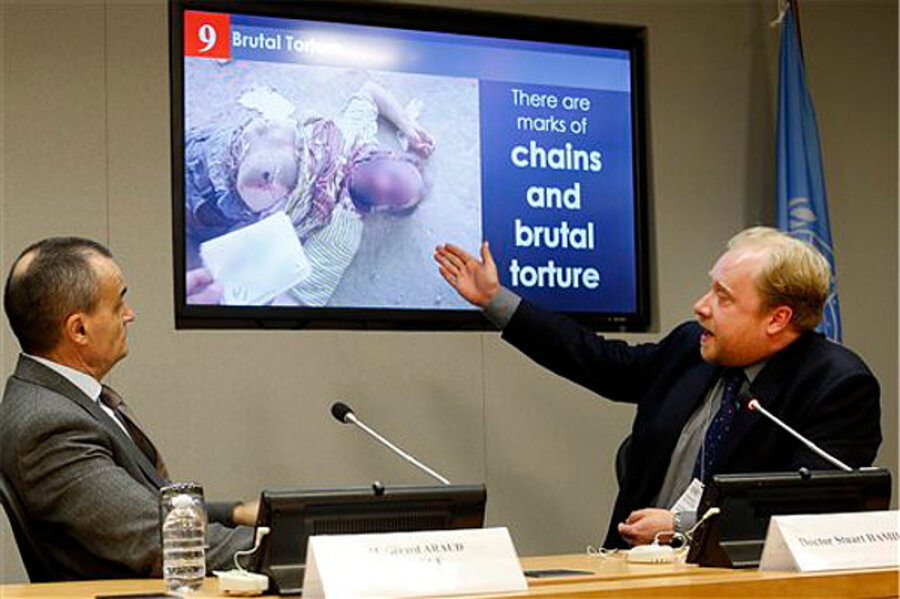UN Security Council sees grim images of Syrian dead
Loading...
| UNITED NATIONS
The UN Security Council fell silent Tuesday after ambassadors viewed a series of ghastly photographs of dead Syrian civil war victims, France's ambassador said. The pictures showed people who were emaciated, with their bones protruding, and some bearing the marks of strangulation and repeated beatings, and eyes having been gouged out.
French Ambassador Gerard Araud said the pall of silence lingered, and then questions slowly began about the credibility of the slides of the dead, who offer mute testimony to the savagery of a Syrian civil war in which more than 150,000 have died.
The council members saw more than the 10 photos publicly released in January on the eve of the "Geneva 2" peace talks as part of a forensic investigation funded by the government of Qatar — a major backer of the opposition and one of the nations most deeply involved in the Syrian conflict. France, which hosted the presentation at the Security Council and showed the images afterward at a news conference, said they are evidence of war crimes by the government of Syrian President Bashar Assad.
The veracity of the photos could not be independently confirmed. Syria's Justice Ministry has dismissed the photos and accompanying report as "lacking objectiveness and professionalism" and said some of the people were militants killed in battle and others were killed by militant groups.
Among the new photos was an image of at least a dozen bodies laid out on the floor of a warehouse, in the process of being wrapped in plastic sheets, with men in military garb standing among them. One of the authors of the report, former Sierra Leone Special Court prosecutor David M. Crane, said it was firm evidence of "industrialized systematic killing."
"Bodies in, bodies out. It was a very systematic processing of human beings. They were laid out in a parking lot because there were too many to put into the morgue," Crane said,
"Doesn't this bring back some interesting images from Dachau, and Auschwitz, and Bergen-Belsen?" Crane observed, sitting in front of the grisly procession of photos projected behind him in a UN news conference.
"The gruesome images of corpses bearing marks of starvation, strangulation, and beatings ... indicate that the Assad regime has carried out systematic, widespread and industrial killing. Nobody who sees these images will ever be the same," US Ambassador Samantha Power said.
The photos were selected from among 55,000 images of tortured and slain Syrian war victims said to have been smuggled out of Syria.
The savagery of the victims' last moments was obvious. One photograph of a person's face showed an eye gouged out, and a spray of blood that gushed a few inches from the eye socket onto the ground beside the head.
Other bodies bore parallel marks that Dr. Stuart J. Hamilton said are known to forensic pathologists as a "tram-line bruise" caused by being struck with a rod. It leaves two parallel welts with a smooth space between them. One body had a series of such bruises up and down his torso. "In a fight or combat, the individual would be moving," Hamilton said, so there would not be a regular pattern of stripes.
Crane said that these photos were "just the tip of the iceberg. We have a snapshot here of just three detention centers" that were funneling their victims to the photographers. He said that some 50 detention centers are known to exist in Syria.
The presentation at the Security Council was part of a process of documenting evidence of Syrian war crimes in the hope of eventually referring the perpetrators to the International Criminal Court in The Hague. But because Syria never accepted the jurisdiction of the ICC, the only way a case can be opened while Assad is in power is for the Security Council to order a referral. Russia and China have used their veto power three times to block resolutions threatening sanctions on Syria.
Araud said France would gladly support a referral of all war crimes and crimes against humanity in Syria — by the Assad regime or by the rebels — to the International Criminal Court if Russia or China allowed it.
He and Crane explained that the trove of torture photos had come from a man code-named "Caesar" who had been a crime scene photographer for the Syrian military.
When the civil war began, he and his colleagues were reassigned to photograph the tortured bodies of rebels and dissidents, providing proof to the regime that its enemies had been liquidated in detention. Their relatives were told that the victims had died of "a heart attack or breathing problems." Bodies were buried before relatives could view them.
A relative of "Caesar" who defected early in the civil war kept in contact with him, and persuaded "Caesar" to copy and collect the images over the next three years, the report says.
"Essentially, 'Caesar' became a spy," Crane said.
Crane said he and his colleagues found "Caesar" to be credible when they interviewed him in January.
In the collection of 55,000 images, each body was photographed four or five times, so the "Caesar Report" authors estimate that about 11,000 victims are pictured.
The forensic team examined about 5,500 of the images and found that almost all were of men aged 20 to 40; only one woman was pictured, and she was clothed; and there were no children in the images. The pathologists found that in a representative sample of images they studied, 62 percent showed emaciation. Nineteen percent showed neck injuries, and "16 percent showed evidence of ligature marks on the neck."
Copyright 2014 The Associated Press. All rights reserved. This material may not be published, broadcast, rewritten or redistributed.







